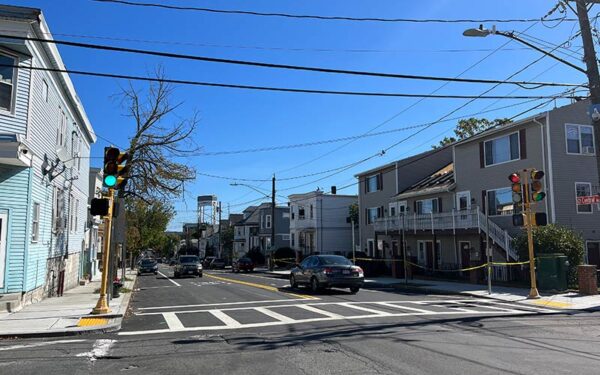
Don't let the gas industry scare you into believing we need a massive new pipeline into New England. Our energy supply is just fine, even in winter. Photo: Justin Henry / CC BY SA 2.0
Following a week of mild temperatures, New England is bracing for the cold to come. Last year, we weathered the worst cold snap that we’d faced in 100 years, complete with a new phenomenon known as a “bomb cyclone.” Now don’t be mistaken, this “bomb cyclone” did not involve Armageddon, the sky falling, or even blackouts due to energy shortages. But you’d have thought so based on the news. The reality is that while wholesale electricity prices increased a bit with the cold – particularly during the few hours each day when power demand was at a peak (mostly mornings and evenings when everyone is at home) – our energy system weathered the frigid temps remarkably well, and clean energy excelled.
That didn’t prevent supporters of big gas pipeline projects, including our electricity grid operator and the gas industry, from once again trying to instill fear in us. Their increasingly tired argument: That without expensive new gas infrastructure projects, we are doomed to high electricity prices, unreliable power, and oil emissions polluting our air.
But we’ve been here before. We didn’t buy into Big Gas’s arguments then, and we’re not buying them now. New Englanders simply won’t foot the bill for billions of dollars’ worth of new pipelines that our climate and wallets cannot afford – and that aren’t actually needed to keep the lights on and our homes warm. And lessons we’ve learned over the past year, including through last year’s cold spell, only hardened that resolve.
Extended Cold Snap Wasn’t a Problem for our Electricity Grid
We’ve heard from various quarters, particularly from our grid and markets operator ISO-New England, that without more gas pipelines we will be at risk of power shortages. This claim has never had merit, and last winter dispelled it altogether.
To begin with, ISO-New England always has a surplus of power generation available – over 33 percent more than it needs during times of highest winter demand. Many of our gas power plants are also capable of burning oil if gas supplies run low or prices spike. So during last year’s cold spell, when gas prices spiked all over the country, our system relied on gas-fired power for less than 20 percent of its electricity supply (down from 45–50 percent usually), and the system was fine. Even when the Pilgrim nuclear power plant shut down unexpectedly in the midst of this cold, due to a downed transmission line, other resources seamlessly stepped in to fill the void.
Clean Energy and Hydropower Kicked In to Fill the Gas Gap
One of the reasons the electricity system could easily handle this significant drop in gas-fired power was the performance of renewable energy and hydropower. During the interminable cold, these clean resources represented as much as 20 percent of our power. That’s right: clean energy was matching our gas-fired power.
Among those renewables, wind was leading the way while individual solar units were powering homes and business, keeping down demand for electricity from big power plants. So, if clean renewables flourish during these periods of cold, why would we ever invest in more of the polluting gas that causes price volatility rather than clean, price-stable, renewable energy?
The Grid Relied Too Much on Oil-fired Power, But It Needn’t Have
Much has been made of the fact that dirty oil was the fuel of choice for power generators when temperatures dipped to their lowest. But this spike in oil use is a direct result of our over-reliance on gas. It should concern us, but it’s important that we put it in perspective.
First, even with the increased oil usage over those few weeks, oil-fired power constituted only a tiny fraction of our overall power generation for the year. That means climate impacts from its overuse during the cold snap were minimal. Second, oil dominated in part due to an ISO-New England program that favors oil as a substitute for natural gas over other, cleaner alternatives. Generators switch to oil because ISO-New England gives them an incentive to do so.
Fortunately, our region is in the process of major investments in new clean energy that will be cheaper (and cleaner) than oil. Our ongoing clean energy investments will displace oil and gas polluters during future cold spells.
Electricity and Gas Prices Were High in Much of the U.S.
The extremely high price of gas resulted in a spike in electricity prices, a concern for every one of us when trying to pay our bills, and especially for low-income and vulnerable communities. But contrary to the gas industry’s fear-mongering, expanded gas pipelines won’t help. Indeed, gas prices were high over those few weeks virtually countrywide.
Pennsylvania, New Jersey, Maryland, and a few other states that sit on top of large gas supplies and have built out their pipelines also saw their electricity prices spike during the cold weather – at times outpacing the spikes in New England. We saw the same phenomenon in 2014. So, even if we were willing to pay billions for new pipelines that will sit idle 95 percent of the time – and could stomach the high costs to our environment and climate – it’s clear that such a buildout is not the solution to high winter electricity prices. We can only achieve that by cutting our reliance on gas in favor of clean, price-stable, renewable power sources.
What’s more, New England has seen its wholesale electricity prices decline steadily for three years, and the temporary increases associated with recent arctic air are not likely to derail that trend.
New Pipelines Just Don’t Make Economic or Environmental Sense
If big new gas pipelines are the great solution claimed by Big Gas, then why don’t they invest their own money into the projects? Instead, they’d rather we the consumers take all the risk while they and utility companies make all the profits. We know a bad deal when we see one, though, and studies from the Massachusetts Attorney General’s Office and the Maine Public Utilities Commission, as well as from a few of the top energy consulting firms in the U.S., demonstrate that new pipelines will cost us much more than any supposed benefits.
Rather than saving New Englanders money as Big Gas likes to promise, new pipelines would end up costing those who pay a monthly electric bill as much as $277 million over their lifetime. This, along with serious legal issues, is why state courts and utility commissions have rejected pipeline proposals like Kinder Morgan’s Northeast Energy Direct pipeline and Spectra’s Access Northeast proposal.
New Pipelines WON’T Help with Price Spikes
So let’s stop the fear-mongering. Its past time for utilities and the gas industry to help New England work toward real solutions that will position us to save money year-round on our electricity bills, reduce price spikes during the winter, and move us toward a clean energy economy. Local clean energy is here to stay – we won’t let the cold scare us back to polluting pipelines while we’re expanding upon better solutions.



